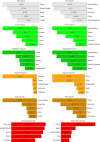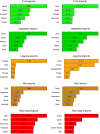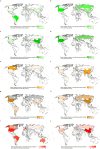International food trade contributes to dietary risks and mortality at global, regional and national levels
- PMID: 37814079
- PMCID: PMC10589094
- DOI: 10.1038/s43016-023-00852-4
International food trade contributes to dietary risks and mortality at global, regional and national levels
Abstract
Food trade is generally perceived to increase the availability and diversity of foods available to consumers, but there is little empirical evidence on its implications for human health. Here we show that a substantial proportion of dietary risks and diet-related mortality worldwide is attributable to international food trade and that whether the contributions of food trade are positive or negative depends on the types of food traded. Using bilateral trade data for 2019 and food-specific risk-disease relationships, we estimate that imports of fruits, vegetables, legumes and nuts improved dietary risks in the importing countries and were associated with a reduction in mortality from non-communicable diseases of ~1.4 million deaths globally. By contrast, imports of red meat aggravated dietary risks in the importing countries and were associated with an increase of ~150,000 deaths. The magnitude of our findings suggests that considering impacts on dietary risks will become an important aspect of health-sensitive trade and agriculture policies, and of policy responses to disruptions in food chains.
© 2023. The Author(s).
Conflict of interest statement
The authors declare no competing interests.
Figures







References
-
- FAOSTAT (FAO, 2022).
-
- Smith VH, Glauber JW. Trade, policy, and food security. Agric. Econ. 2020;51:159–171. doi: 10.1111/agec.12547. - DOI
-
- Martin, W. Agricultural Trade and Food Security ADBI Working Papers (ADBI, 2017); https://ideas.repec.org/p/ris/adbiwp/0664.html
-
- D’Odorico P, Carr JA, Laio F, Ridolfi L, Vandoni S. Feeding humanity through global food trade. Earths Future. 2014;2:458–469. doi: 10.1002/2014EF000250. - DOI
MeSH terms
Grants and funding
LinkOut - more resources
Full Text Sources

